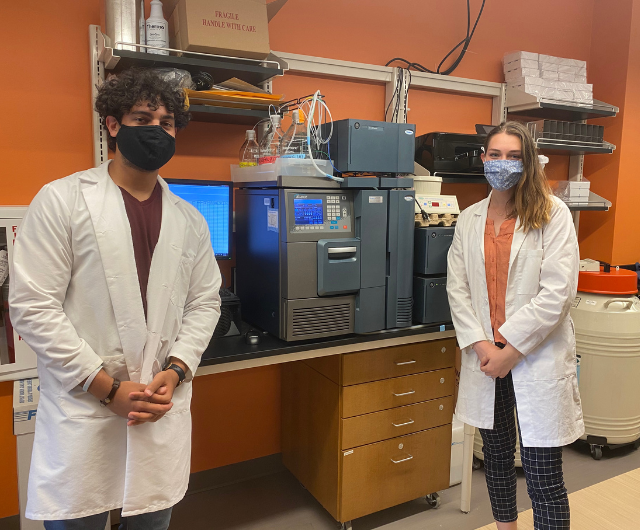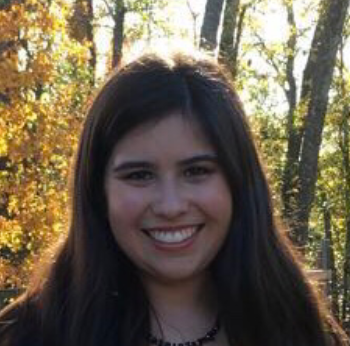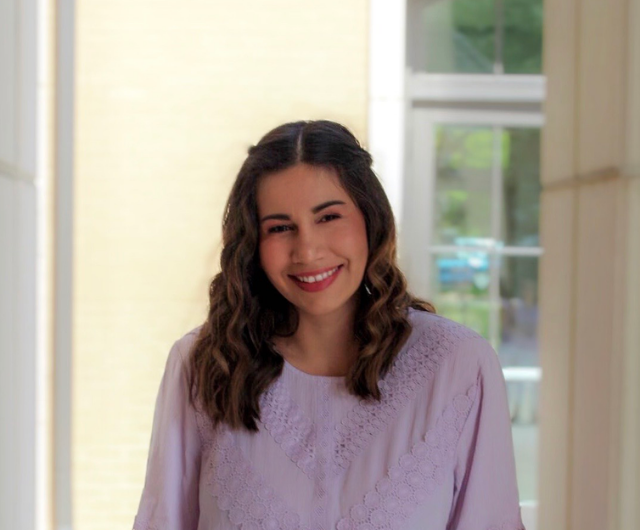The University of Texas at Tyler began its Lyceum in 2016. Katherine Stone, UT Tyler’s Honors Program coordinator, said the Lyceum’s intention was “providing a space and moment for UT Tyler students to share their research with the campus community.”
Stone said the Lyceum filled a need for a campus-wide forum for student research. The Honors Program and The Center for Excellence in Teaching and Learning designed the event and named it after Aristotle’s school in ancient Athens as a space for public lectures and discussions.
This year, 134 students submitted Lyceum presentations. The Tyler Loop reached out to a few of the students to learn more about their research topics, methods and impacts. Here, we highlight five impressive student projects from undergraduates and graduates across multiple disciplines.
Meet Ruth Nwokora, UT Tyler graduate student

Topic: The Political Agency of Women in Colonial Africa
Faculty mentor: Dr. Amentahru Wahlrab
What did your work reveal?
“[My] paper shows that African women contributed immensely to the decolonization process [throughout the content of Africa],” said Nwokora. “Without women’s constant rebellion, protests, riots, and battles, the continent’s independence would have come much later.”
Nwokora provides details of the Ashanti warriors of Ghana, the riotous women of Eastern Nigeria and the Senegalese women who marched against the French empire to support her claim.
The second part of Nwokora’s paper focuses on African womens’ roles in the post-colonial state. “The political agency of women was often stymied by western ideologies intended to keep women ‘in their place,’” said Nwokora. “In this way, African women were colonized twice: once by the Western powers and their religions, and second by African elites that denied women access to economic and political power.”
Nwokora says that African women continue to resist oppression, evidenced by more women presidents elected on the continent than in any other region in the world.
Why did you choose this topic?
“Whenever I tell people, especially in Nigeria, that I am getting a Master’s Degree in Political Science, they ask, ‘Are you planning on using that degree in Africa?’” said Nwokora. “I wanted to know why people believe women should stay away from the political sphere, especially when most of our African elites have failed to move the continent in the right direction.”
What surprises came out of your research?
“I was not expecting to find many female political figures in African pre-colonization,” said Nwokora. “To my surprise, that was not the case. Before the West’s colonial rule, African women were the backbone of the continent’s political sphere. Women were active and alive in their role as political figures in the public sphere.”
What does your topic say about Tyler and East Texas?
“When nations refuse to highlight women’s roles in society, girls do not get to see a representation of themselves in high places. Women [are sometimes] confined to the private sphere, unpaid for their labor as wives and mothers. Representation matters a lot. I want for girls worldwide, including Tyler, to see themselves as president someday,” said Nwokora.
Meet Sarah Thompson and Abdullah Alkarboly, UT Tyler graduate students

Topic: HPLC Analysis of Active Ingredient Content of Cannabidiol (CBD) Products Commonly Used by UT Tyler Students
Faculty mentors: Dr. Ayman Hamouda and Dr. Brittany Parmentier
What did your researching reveal about CBD use among UT Tyler students?
“The two purposes of the study were to determine cannabinoid contents of CBD products most commonly used among UT Tyler students and to determine CBD content recovery under conditions that simulate gastric and intestinal physiological fluids,” said Thompson.
Thompson notes that Texas-legal CBD products containing less than 0.3% of THC (tetrahydrocannabinol) are not manufactured under standard pharmaceutical practices. Since their legalization, oils, capsules, topical products and food products have increased exponentially. “Variabilities in quantities and formulation of cannabinoid content results in unpredictable product outcomes including posing a health risk,” said Thompson.
The lack of control over CBD product processing can lead to surprising results. “[Some] products that do not contain the levels of CBD claimed or are processed in a way that is not suitable for CBD dissolution in the gastric and intestinal fluids,” said Thompson.
How did you choose this subject?
“Our sponsor, Dr. Brittany Parmentier, chose this subject after noticing the prevalence of CBD interest among her patients,” said Thompson. “ We noticed many of our peers and family express an interest in using CBD products, and we were curious as to what was really in these products and if they contained what the label claimed.”
Help us understand how you analyzed your samples.
“We prepare samples in a way that mimics normal human digestion and then run them through a process called an High Performance Liquid Chromatography (HPLC) to identify cannabinoids,” said Thompson. “We then take this data and convert it into how much of the product is being absorbed in the body.”
What surprises came through your research?
“We were both surprised how little CBD was being absorbed through our method,” said Thompson. She said the varying quality of products on the market is concerning. “We realized that in one product, at most only 60% was being absorbed,” she said.
What do your conclusions say, if anything, about life and issues in Tyler?
Thompson said that the popularity of CBD products in Tyler is increasing rapidly. “A quick 10-minute drive down Broadway will yield more than a handful of CBD stores,” she said. “We hope that our findings will help consumers use caution when purchasing or debating to purchase these products.”
Meet Autumn VanBurkirk, UT Tyler undergraduate student

Topic: Responsible Residential Development: An Overview of Tyler, Texas’s Residential Building Permits
Faculty mentor: Dr. Matthew Kelly
What is your study’s focus around Tyler’s building permits?
“Residential housing is an important indicator of economic well-being, and informed residential development can prevent condensed pockets of impoverished or underserved communities,” said VanBuskirk. She said her study aims to quantify Tyler’s most recent residential development happening in Tyler and to identify if there are concentrated areas of high or low end housing.
How did you research your topic?
“My study examines the residential building permits issued in Tyler from 2017-2019, which include the permit location and the value of the property being built,” said VanBuskirk. She plotted permit locations an interactive map, and the pinpoints are color-categorized by the value of the property. “Location is evaluated by zip code, and property value is categorized in groups, such as $100,000-$200,000 or $300,000-$500,000,” she said.
What were your findings?
VanBuskirk’s residential plotting confirms that most of Tyler’s new high-end housing is in the 75703 area, while most of the new low-end housing is in the 75701 and 75702 area. The 75703 area also has significantly more permits issued. “These findings do not account for preexisting properties, nor for the race, gender, education or income of a property’s homeowner,” said VanBuskirk. Nonetheless, her observations can provide a focus when considering future residential development goals in Tyler.
Tell us about the reason you chose your subject.
“This idea was prompted by an assignment for one of my major classes to take a data-driven approach to a national or local issue. While I was thinking of an idea, I saw a news clip about an incentive program the City of Tyler was doing to promote residential development in north Tyler. After looking on the city website, I found some records of residential building permits issued in Tyler from 2017-2019,” said VanBuskirk.
She said the information was detailed and extensive, and the idea to create an interactive map from the files was born. “As a native Tylerite, I could see differences in housing around me, but I didn’t have a way to quantify what I was seeing. I was hoping this project could help explain some of the trends I was observing,” she said.
What insights that came through your research?
“Of the 870 residential permits recorded on the map, 47% were issued in 75703, 16% were issued in 75701, and 11% were issued in 75702,” said VanBuskirk.
She said most homes valued at $100,000-$200,000 were issued in 75701.
Of homes valued at $200,000-$300,000, the largest percentage were issued in 75703.
For homes valued at $300,000-$500,000, 67% were issued in 75703.
Of homes valued at $500,000-$1,000,000, 74% were issued in 75703, and 0% were issued in 75702.
What do your conclusions say about life in Tyler?
“While this project didn’t account for preexisting properties or homeowner demographics, it did provide some insight into the general condition of residential development happening in Tyler.
“Recently, Tyler City Council has taken steps to create incentive programs and new opportunities to bring more homeowners and businesses to north Tyler. Private entities also appear to be getting involved in this effort, so it seems we are trying to reach for a positive change,” said VanBuskirk.
Meet Monu Jaiswal, UT Tyler undergraduate student

Topic: Design and Optimization of Acoustic Metamaterial for Noise Reduction and Focusing
Faculty mentor: Dr. Tahsin Khajah
What was the focus of your study?
“Wave manipulation of low-frequency sound remains a major challenge in the field of acoustics. In this work, we present analysis and optimization for focusing and noise reduction at targeted frequencies,” said Jaiswal. For noise reduction, Jaiswal used a Wunderlich curve as the initial design and was able to reduce noise inside the duct by over 99%. He says noise reduction has applications in fields including biomedicine, aerospace, military and communication.
How did you choose your topic?
“As a mechanical engineering student at UT Tyler, I have learned that engineering is about creation and innovation. In my field of research, I develop innovative methods and design the required tools for controlling and manipulating sound waves,” said Jaiswal.
He said sound is sometimes ignored as a form of energy. “Within the last few decades, the development of metamaterial (a material designed to control, direct and manipulate sound waves) devices has sparked a research interest to harvest energy generated by sound while reducing noise pollution,” said Jaiswal.
How did your methods differ from popular noise-cancelling headphones?
“Noise-cancelling headphones are utilizing an active noise reduction method to generate counter-waves to cancel incoming sound waves. However, passive noise reduction devices absorb the energy of the sound without any need for electricity and may even harvest sound energy and convert it to electrical energy using piezoelectric materials,” said Jaiswal. “In other words, noise pollution can be canceled without energy consumption.”
How do you imagine this technology being used?
“A range of self-powered sensors can be developed to monitor the structural integrity of buildings, nearby traffic, or even wearable biomedical sensors,” said Jaiswal.
“When focusing the sound waves, we try to concentrate the energy of the sound at a point. This phenomenon is very similar to using optical lenses for light to converge light rays.
Such methods can be very useful in the biomedical field to perform treatments of tumors without open surgery. The tumor temperature is increased by focusing the sound waves without damaging the healthy tissue,” he said.
How does your research relate to Tyler and East Texas?
“This study has numerous applications in aerospace, automobile, biomedicine, communication, energy, and defense industries. This novel technology can bring change by facilitating the development of new devices to support the energy sector and medical infrastructures in Tyler and throughout East Texas,” said Jaiswal.
Meet Emily Santisteven, UT Tyler graduate student

Topic: Supporting a Racially Diverse Facial Dataset: Normative Valence and Arousal Ratings Across Race and Moderation by Race
Faculty mentor: Dr. Sarah Sass
What was the purpose of your research?
“The primary goal was to collect normative emotional valence and arousal ratings using the RADIATE facial database. The RADIATE database is racially diverse, yet underutilized, due in part to a lack of normative valence (how people feel about a face) and arousal (to what intensity they feel about a face) ratings,” said Santisteven. Her secondary goal explored whether the race of the rater moderated emotion ratings.
How was your research conducted?
“In an ongoing study, 204 participants (Asian: 9, Black: 25, Latinx: 39, White: 131) were randomly assigned to one of 10 blocks of 36 faces. Each block included faces counterbalanced on race, gender, and emotion so that each participant rated an identical number of faces with respect to these categories,” said Santisteven. She said participants viewed faces and rated each on valence in a 1-9 rating from unpleasant to pleasant and on arousal in a 1-9 rating, low to high.
What were some findings of your study?
“As expected, across racial face categories, happy faces were rated as more pleasant (M = 6.50) and sad faces as more unpleasant (M = 3.03). In addition, happy (M = 4.29) faces were rated more emotionally arousing than sad (M = 3.76) and neutral faces (M = 3.29). The race of the rater moderated valence but not arousal ratings.
Black raters rated Asian females as happier than Asian males and Latinx raters rated Latinas as sadder than Latinos, with no other evident effects,” said Santisteven.
What does the data tell us?
“Results further suggest that emotional faces are not rated in a universal manner, as some emotion theories presume. I discuss implications of the results and future research directions,” said Santisteven.
Tell the reason you chose your subject of study.
“I chose this subject to get at a gap in the literature. There is a limited amount of facial stimulus databases currently in research that use racially diverse faces,” she said.
Santisteven said she sought to explore whether there was bias from participants when rating the images. “I think this is an important perspective to look at when doing research with racially diverse face images,” she said.
What insights that came through your research?
“We did find some differences between the race of the participants in valence ratings (how unpleasant or pleasant they found the faces) with happy Asian faces and sad Hispanic faces. Present findings may have implications for the universality of emotion theories and the inclusiveness of psychological research,” said Santisteven.
Love what you're seeing in our posts? Help power our local, nonprofit journalism platform — from in-depth reads, to freelance training, to COVID Stories videos, to intimate portraits of East Texans through storytelling.
Our readers have told us they want to better understand this place we all call home, from Tyler's north-south divide to our city's changing demographics. What systemic issues need attention? What are are greatest concerns and hopes? What matters most to Tylerites and East Texans?
Help us create more informed, more connected, more engaged Tyler. Help us continue providing no paywall, free access posts. Become a member today. Your $15/month contribution drives our work.







